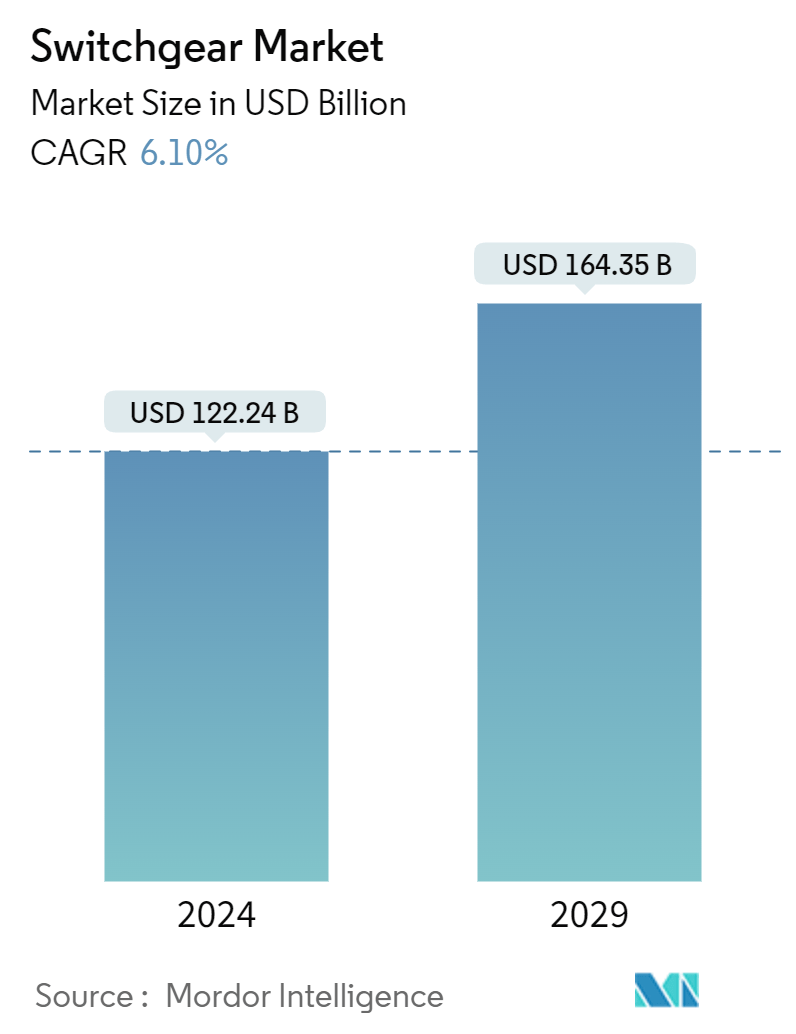Market Size of Switchgear Industry

| Study Period | 2019 - 2029 |
| Market Size (2024) | USD 122.24 Billion |
| Market Size (2029) | USD 164.35 Billion |
| CAGR (2024 - 2029) | 6.10 % |
| Fastest Growing Market | Asia Pacific |
| Largest Market | Asia Pacific |
Major Players
*Disclaimer: Major Players sorted in no particular order |
Switchgear Market Analysis
The Switchgear Market size is estimated at USD 122.24 billion in 2024, and is expected to reach USD 164.35 billion by 2029, growing at a CAGR of 6.10% during the forecast period (2024-2029).
- The rapid development of electricity in rural areas and expanding energy output have increased the need for a wide range of electrical equipment. Key drivers for the switchgear market include heightened regional ambitions to electrify rural areas and escalating investments in the market. Switchgear, a pivotal component in electrical circuits, not only controls and monitors the flow of electricity but also ensures safety, cost-efficiency, and reliability across residential, commercial, industrial, and utility settings.
- Primarily deployed in electrical substations, switchgear is designed to manage voltage fluctuations, especially in challenging environmental conditions. As new industrial infrastructures, like power plants, emerge, the demand for reliable operations further boosts the market. Moreover, as investments in renewable energy soar and governments champion advanced technologies, the sector is poised for significant growth.
- The advanced monitoring technologies embedded in the switchgear will alert maintenance teams about potential breakdowns, providing real-time data on defects and improvement opportunities. However, external factors like temperature, humidity, and groundwater seepage can hamper the performance of outdoor switchgear networks.
- On a broader scale, rising concerns about environmental sustainability and the push for climate change mitigation are steering the industry toward eco-friendly solutions. This shift is evident in the increasing adoption of gas-insulated switchgear (GIS) and solid-state alternatives, which significantly curb greenhouse gas emissions. Notably, environmental initiatives and regulations by governments are shaping the market's trajectory.
Switchgear Industry Segmentation
Switchgear plays a pivotal role in safeguarding power systems. It regulates electrical circuits, manages power distribution, and facilitates testing and maintenance by de-energizing equipment. Key components of switchgear include circuit breakers, isolators, relays, switches, fuses, and control panels.
The switchgear market is segmented by type (voltage (low-voltage, medium-voltage, and high-voltage), insulation (gas-insulated switchgear (GIS), air-insulated switchgear (AIS), and other insulation types), and installation (indoor and outdoor)), end-user industry (commercial, residential, and industrial), and geography (North America, Europe, Asia-Pacific, Middle East and Africa, and Latin America). The market sizes and forecasts are provided in terms of value (USD) for all the above segments.
| By Type | |||||
| |||||
| |||||
|
| By End-user Industry | |
| Commercial | |
| Residential | |
| Industrial |
| By Geography*** | |
| North America | |
| Europe | |
| Asia | |
| Australia and New Zealand | |
| Middle East and Africa | |
| Latin America |
Switchgear Market Size Summary
The switchgear market is poised for substantial growth, driven by the increasing demand for electrical equipment due to the rapid development of electricity infrastructure, particularly in rural areas. This growth is further fueled by significant investments and regional initiatives aimed at electrification. Switchgear plays a crucial role in managing and monitoring electrical circuits, ensuring safety, reliability, and cost-efficiency across various sectors, including residential, commercial, industrial, and utility settings. The market is also benefiting from the rise in renewable energy investments and the adoption of advanced technologies, which are expected to enhance the operational reliability of switchgear systems. However, environmental factors such as temperature and humidity can impact the performance of outdoor switchgear networks. The industry is witnessing a shift towards eco-friendly solutions, with increasing adoption of gas-insulated switchgear and solid-state alternatives, driven by environmental sustainability concerns and government regulations.
The market landscape is characterized by a fragmented competitive environment, with key players like ABB Ltd, Havells India Ltd, Mitsubishi Electric Corporation, Schneider Electric, and Siemens AG actively engaging in partnerships, innovations, and acquisitions to strengthen their market position. The demand for switchgear is further bolstered by the expansion of transmission and distribution networks in emerging economies, such as India, and the significant growth in renewable energy capacity, particularly in China. These developments are paving the way for a burgeoning switchgear market, as new power generation centers and industrial infrastructures emerge. Companies are also focusing on developing advanced monitoring technologies and eco-friendly products to meet the evolving market demands and regulatory standards.
Switchgear Market Size - Table of Contents
-
1. MARKET INSIGHTS
-
1.1 Market Overview
-
1.2 Industry Attractiveness - Porter's Five Forces Analysis
-
1.2.1 Threat of New Entrants
-
1.2.2 Bargaining Power of Buyers/Consumers
-
1.2.3 Bargaining Power of Suppliers
-
1.2.4 Threat of Substitute Products
-
1.2.5 Intensity of Competitive Rivalry
-
-
1.3 Technology Snapshot
-
1.4 Impact of COVID-19 Aftereffects and Other Macroeconomic Factors on the Market
-
-
2. MARKET SEGMENTATION
-
2.1 By Type
-
2.1.1 Voltage
-
2.1.1.1 Low-voltage
-
2.1.1.2 Medium-voltage
-
2.1.1.3 High-voltage
-
-
2.1.2 Insulation
-
2.1.2.1 Gas -insulated Switchgear (GIS)
-
2.1.2.2 Air-insulated Switchgear (AIS)
-
2.1.2.3 Other Insulation Types
-
-
2.1.3 Installation
-
2.1.3.1 Indoor
-
2.1.3.2 Outdoor
-
-
-
2.2 By End-user Industry
-
2.2.1 Commercial
-
2.2.2 Residential
-
2.2.3 Industrial
-
-
2.3 By Geography***
-
2.3.1 North America
-
2.3.2 Europe
-
2.3.3 Asia
-
2.3.4 Australia and New Zealand
-
2.3.5 Middle East and Africa
-
2.3.6 Latin America
-
-
Switchgear Market Size FAQs
How big is the Switchgear Market?
The Switchgear Market size is expected to reach USD 122.24 billion in 2024 and grow at a CAGR of 6.10% to reach USD 164.35 billion by 2029.
What is the current Switchgear Market size?
In 2024, the Switchgear Market size is expected to reach USD 122.24 billion.

